#Vincent Youmans
Text
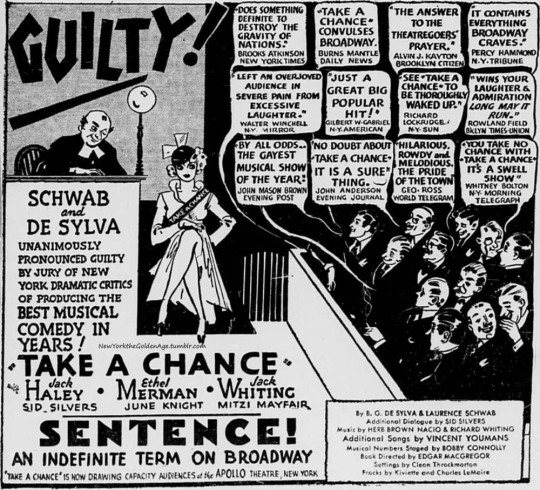
In Variety, December 6, 1932: an ad for Take a Chance, starring Ethel Merman, Jack Haley, and Jack Whiting.
from Tom Samuels on Broadway Remembered, Facebook
#New York#NYC#vintage New York#1930s#Take a Chance#vintage Broadway#Ethel Merman#vintage ads#Jack Haley#Jack Whiting#Variety#Broadway musicals#December 6#Dec. 6#Buddy de Sylva#Vincent Youmans
24 notes
·
View notes
Text
Liza!!!
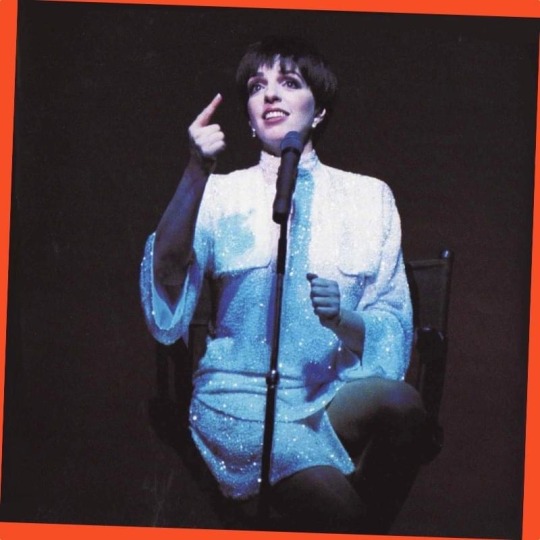
Known for her belting, I think she is one of our best ballad singers! This Week on Everything Old Is New Again Radio Show's
March 10th & 13th broadcasts, we feature the music of Liza Minnelli ("Softly, Slowly" - a broadcast of ballads)
Some of the ballads from her career that we will hear:
*You Are For Loving
*Charles Aznavour's Quiet Love
*More Than You Know (Vincent Youmans / Billy Rose / Edward Eliscu)
of course, *A Quiet Thing
and *Spring Is Here And MORE!
Visit www.oldisnew.org for more info!
EverythingOldIsNewAgainRadioShow #45thYear #PopStandards #GreatAmericanSongbook #Jazz #Showtunes #Cabaret #broadway
#everythingoldisnewagainradioshow#45thyear#popstandards#greatamericansongbook#jazz#showtunes#cabaret#broadway#everything old is new again#wbai
2 notes
·
View notes
Text
DAYBREAK
1917
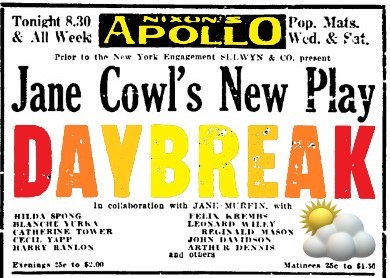
Daybreak is a play by Jane Cowl and Jane Murfin. It was originally produced by Selwyn and Company staged by Wilfred North and Miss Cowl.
Successful businessman Arthur Frome, who drinks too much, pushes a newsboy under an automobile, thus causing him severe injuries. His wife Edith then becomes disillusioned with her husband and leaves him. After an absence of a few years, Edith returns to her husband but offers no explanation of her behavior. Soon, however, Arthur becomes suspicious when she and their family friend, Dr. Brent, frequently visit a house in which a small child is living. Arthur has Edith followed by the wife of one of his employees, whom he has caught stealing, and soon discovers that the child, who is gravely ill, is his own. Edith confesses that she did not want to raise their child under the influence of a drunkard and so left him in someone else's care. Soon after this confession, Arthur is shot by the husband of the woman who has followed Edith because the man suspected his wife of having an affair. Arthur recovers, however, as does the child, and through Dr. Brent's intervention is happily reconciled with Edith, with whom he plans a new life.
About the Title: The play begins at daybreak in a darkened hallway of a New York apartment. Cowl and Murfin were intent on creating the mood of daybreak without resorting to clichés that might result in laughter. They nixed a visit from the milkman and a crowing rooster. They settled on a single shaft of yellow light piercing the darkness of the quiet room. The first scene is played in silence with no dialogue to create the ‘hush’ of early morning.
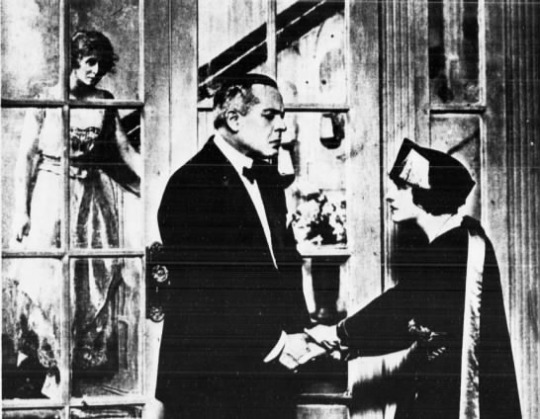
Daybreak premiered in Atlantic City at Nixon’s Apollo Theatre on the Boardwalk on June 18, 1917.
“[The play] was presented to early summer reporters at Atlantic City. It will not, therefore, be an unusual sight in Atlantic City to see a large number of people going home after ‘Daybreak'.” ~ WASHINGTON POST
Edith Frome was played by Blanche Yurka, a performer that Cowl had worked with and promised to help in her career. She was later cast in another play by Cowl and Murfin. Arthur Frome was played by Frederick Truesdell, one of Broadway’s most popular leading men.
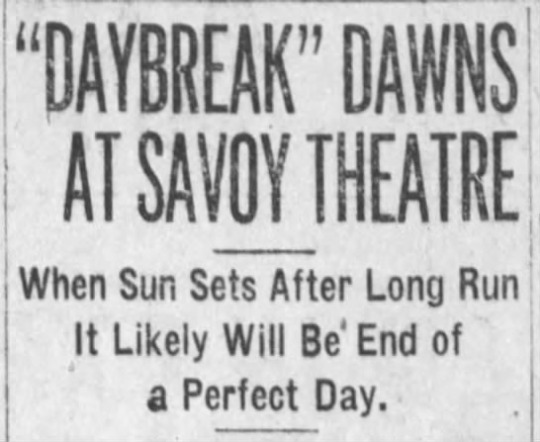
In late July and early August, the play was seen on the Jersey shore in Asbury Park at The Savoy and Long Branch at the Broadway.
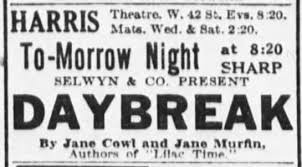
Daybreak opened on Broadway at the Harris Theatre (254 West 42nd Street) on August 14, 1917.
About the Venue: The Harris (named after William B. Harris) was built in 1904 as the Lew Fields Theatre. It was variously known as the Hackett, Wallacks, the Frazee, and finally the Anco Cinema. In 1988, the interior was gutted and it was used as retail space. It was finally demolished in 1997 as part of the 42nd Street redevelopment.

This was the second collaboration between Cowl (above) and Murfin, who previously penned Lilac Time earlier in 1917. Cowl also performed in Lilac Time, which closed on June 9th at The Harris (having transferred from The Republic), allowing Daybreak to move in. Between the two plays, Lilac Time proved the more popular and more successful. In October 1918 they collaborated on a third production, Information Please, with Cowl again performing, which was less successful still. In December 1919, the pair had their most successful script, Smilin’ Through, although they wrote it under the pseudonym Allan Langdon Martin. It inspired two films and two television adaptations. In 1932, Smilin’ Through was the basis for a flop musical titled Through The Years by Vincent Youmans.
"I am really pretty tired," she said. "You see, last summer was a strenuous one. I live at Great Neck on Long Island, and my movie work was done at Fort Lee NJ. I used to get up every morning at 5:30 am and shortly after after 6:30 I was in my car and on my way to Fort Lee. At 7 I was in my dressing room, by 8 I was in the studio. Then it was work until 5 or 6, with a short time off for lunch. Back to New York and rehearsals for "Daybreak,” my new play, until all hours. ~ JANE COWL, OCTOBER 7, 1917
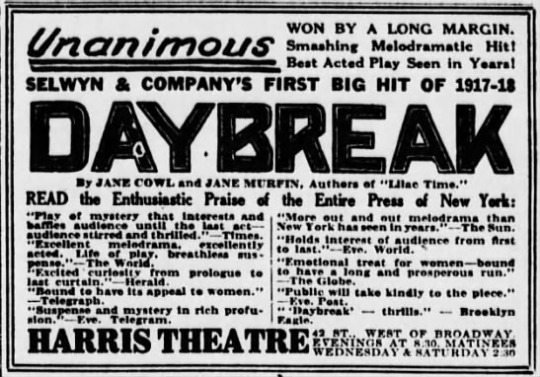
After the play was established on Broadway, Jane Cowl joined the road company of her Lilac Time. As of October 1917, Cowl was also seen on cinema screens in The Spreading Dawn (a title oddly similar to Daybreak), a civil war drama.
Daybreak closed on Broadway on October 13, 1917 after 71 performances.

Daybreak was filmed in 1918 starring Emily Stevens and Julian L’Estrange. It is now considered a lost film.
#Daybreak#Jane Cowl#1917#Jane Murfin#Selwyn & Co#Nixon's Apollo Theatre#Broadway#Broadway Play#Harris Theatre
18 notes
·
View notes
Text
11/24 おはようございます。Ralph Towner / Blue Sun ECM1250 等更新しました。
Billie Holiday / All or Nothing at All v6-8329Bobby Hackett / In A Mellow Mood t-575Pat Moran / Quartet Bcp6007Zoot Sims / New Beat Bossa Nova Cp435Bob Brookmeyer Al Cohn / Storyville Presents Bob Brookmeyer STLP305Oscar Peterson / Plays The Harry Warren And Vincent Youmans Song Books mgv2059Ben Webster / Soulville mgv8274Johnny Hodges / at the Sportpalast Berlin 2620102Chet Baker & Paul Bley /…

View On WordPress
0 notes
Text
Birthdays 9.27
Beer Birthdays
Samuel Adams (1722)
Eberhard Anheuser (1806)
Carl Adolf Riebeck (1821)
Conrad Seipp (1825)
Charles L. Centlivre (1827)
Louis Alphonse Centlivre (1857)
Frank D. Yuengling (1876)
David Farnsworth (1927)
Five Favorite Birthdays
Randy Bachman; rock guitarist, singer (1943)
Wilford Brimley; actor (1934)
Thomas Nast; cartoonist (1840)
Bud Powell; jazz pianist (1924)
Jim Thompson; writer (1906)
Famous Birthdays
Henri Frederic Amiel; Swiss writer (1821)
Harry Blackstone; magician (1885)
Shaun Cassidy; pop singer (1958)
William Conrad; actor (1920)
Don Cornelius; "Soul Train" television show host (1936)
George Cruikshank; illustrator (1792)
Cassandra Cruz; porn actor (1982)
Cytherea; porn actor (1981)
Cosimo de' Medici; merchant prince (1389)
Greg Ham; rock woodwind player, keyboardist (1953)
Dillon Harper; porn actor (1991)
Avril Lavigne; rock singer (1984)
Marc Maron; comedian (1963)
Meat Loaf; rock singer (1947)
Jayne Meadows; actor (1920)
Greg Morris; actor (1933)
Don Nix; baritone saxophonist (1941)
Gwyneth Paltrow; actress (1972)
Arthur Penn; film director (1922)
Mike Schmidt; Philadelphia Phillies 3B (1949)
Jim Shooter; comic book writer, artist (1951)
Top Cat; cartoon character (1961)
Lil Wayne; rapper (1982)
Vincent Youmans; songwriter (1898)
1 note
·
View note
Text
"Tea for Two" written in 1924 by composer Vincent Youmans and lyricist Irving Caesar for the broadway show "No, No, Nanette." It became the biggest hit of the show and of Youman's career in general. I particularly love this song because it was sung in the 1975 documentary "Grey Gardens" by Big Edie Beale in quite a stunning rendition! Here it is sung by my dear friend Kerry Kincannon who recently visited me in my home and we recorded this on the fly. I have been wanting to sit and play songs with her for such a long time! It was a great experience and we're sure to do it together again. This is just a great song and I'm pleased to post it here for it's (almost) centennial!
1 note
·
View note
Text
ALMOST COUCH TOUR: BILL CHARLAP with Peter Washington and Kenny Washington, SMOKE JAZZ CLUB, 27 JANUARY 2023, 9 pm set
This was a can’t miss run anyway, but I had hopes of watching it with my Toledo friend. Unfortunately, as happens, he was called away, but good old Smoke Screens, they call it, stay live for 3 days. So even though we got the Friday night one, it wasn an easy matter to watch on Sunday afternoon.
Can’t miss—because all three are about as good as it gets and their long-standing partnership makes them together more than their considerable parts.
Can’t miss—because of BILL CHARLAP’s vast knowledge of the Great American Song Book repertoire.
Can’t miss—because he has been one of my favorite pianists, the first one I saw at Jazz St Louis.
But, of course, it wasn’t quite what I expected which is precisely why I listen to this music.
It was only on the last two tunes that my notes said “signature Charlap” for, first, a gentle standard where he/they caressed the chords and the uptempo closer which might well have been an Ellington following Sophisticated Lady and Love You Madly. I suppose those two were signature too—sophisticated and brisk and bouncy by turns, but there was an edge of adventure in there as if Charlap was willing to go against type. Yes, they were suits and ties, but this has never been cabaret music. Maybe wife Renee Rosnes shows him about taking risks; maybe I’m just a sophisticated listener.
Still, Charlap is singular and this band is amazing.
Sometimes I’m Happy and a breakneck Tea for Two, both by Vincent Youmans we were helpfully informed, opened. The former was mostly gentle but he would punctuate with hard chords; he skated around the melody of the latter before stepping on the throttle. Peter Washington wasn’t even winded as he kept up on bass.
Then the Ellington tunes and Smoke Gets in Your Eyes. I failed to name that next tune before Gerald Wiggins’ A Fifth for Frank. I’ve heard Charlap play some Mulligan tunes and there are today’s Ellingtons which sort of don’t count, but he doesn’t play jazz compositions as such all that often. Yet, as I look up Wiggins, I can imagine that Charlap would have heard him often with singers like Helen Humes, Lena Horne, Kay Starr, and Eartha Kitt.
So there were some surprises en route to the homestretch of the set which finally seemed “signature.” One signature element that was there from the start was Kenny Washington’s taste and power. He burned but also showed solos/showcases that were deceptively simple. Charlap called him an ”informal rhythm machine” and that’s apt.
That Bill Charlap wasn’t quite what I expected makes me look forward to the next time all the more.
0 notes
Text
Art Tatum's arrangement of Youmnans' Tea for Two (sheet music)
Art Tatum's arrangement of Youmans' Tea for Two (sheet music)
Best Sheet Music download from our Library.
Please, subscribe to our Library. Thank you!
Art Tatum's arrangement of Youmans' Tea for Two (sheet music)
https://youtu.be/AvJAKMg58yI

Art Tatum is considered by many to have been one of the great pianists of our century, irrespective of genre. Pianists from all fields have acknowledged his phenomenal technical and improvisational abilities. Vladimir Horowitz and Sergei Rachmaninoff are on record as having been astonished by his playing.
Over the years, Tatum recorded several different versions of Vincent Youmans' Tea for Two, the earliest in 1933. As a matter of fact, each subsequent recorded version embodied substantial changes compared to its predecessors.
As with most of his other transcriptions, this one was never written down or published by Tatum himself. Perhaps because the rhythm is so regular throughout this earliest version, in comparison with later recordings, it automatically became the target of choice for attempts to notate it.
Jed Distler notated the work a few years ago, and a recording of his notation, as somewhat modified, was included in Stephen Mayer's CD of Tatum favorites issued on the ASV label Brent Edstrom also made an attempt at notation, which was published in "The Tatum Collection" by Hal Leonard Corp. in 1995. There are probably others.
The accuracy of previous attempts at notating such recorded, but unpublished, works (including some of the Ho10witz transcriptions notated by Jan Holeman and Valery Kuleshov) has been limited by the acuteness of the ear of the transcriber.
When the multispeed tape recorder came on the market, it became possible to copy a recording, and then play it back at half-speed, which helped to identify the notes played in rapid passages. These could be further slowed down by dropping to one-quarter speed; but in all of these cases, there was one fundamental disadvantage:
The pitch inexorably dropped an octave each time the tape speed was halved, so that already low-pitched notes became more difficult to identify with each step, and it became more of a problem in some cases to identify accurately the register involved.
With the advent of the personal computer and the multitude of programs which have come on the market in its wake, it was inevitable that sooner or later a program would be introduced which could lower the speed of a recording without dropping its pitch. Such a program is WaveSE™, a Windows™-based sound-editing program, which can do just that It is only through the use of this program that it became possible to produce, with what is believed to be considerable accuracy, the present edition of Art Tatum's arrangement of Tea for Two. (*)
With a copy of Jed Distler's sometimes incomplete notation of Tea for Two in hand, it was the editor's initial intent to try to fill in certain measures which were left blank in Distler's notation, but after a one-third-speed copy was made of the entire piece, a number of discrepancies were noticed in addition to the blank measures.
Tue use of such a technological aid, of course, does not mean a keen ear and careful listening become unnecessary. Far from it. But at least with a one-third-speed copy (or one reduced even further to one-ninth or one-twenty-seventh speed in order to help illuminate very rapid passages), the individual notes are now more or less isolated for closer inspection and more certain identification.
No one, of course, can guarantee that every note or chord, or every rhythmic intricacy, has been positively identified, especially when we are dealing with a shellac recording sixty-five years old, with its concomitant surface noise, but the editor has done his best to provide as accurate a notation as possible.
Attention should be drawn to the occasional quintuplet figures used by Tatum (see examples in measures 42. 54, 87, 92 and 95), which at very slow speed are usually determined to be rhythmic combinations of 2 + 3 or 3 + 2 rather than an even 5.
Other apparent quintuplet groups were heard under our audio magnifying glass to be very slightly different patterns, such as a combination of two 32d notes and three 16th notes. Where such a pattern was clearly identified, it was so notated in our score. These minor irregularities may have resulted from some unevenness in Tatum's playing, or they may have been intentional on his part. At any rate, the difference simply cannot be heard in a full-speed performance, which in the recording moves along at a very steady metronome marking of about 168.
Grateful acknowledgment is hereby offered to Jed Distler, whose notation inadvertently started the editor on his quest for the real Tea for Two and provided the requisite outline of the piece and its harmonies, without which it would have been considerably more difficult to proceed with the project; and to Michael Habermann, who graciously devoted considerable time and effort in providing essential criticism of the successive versions of this notation and suggestions for improving its accuracy until both of us came to the realization that it was time to call a halt to further speculation about the few remaining uncertain passages.
It is believed that the result will be worth the serious attention of any pianist, whether jazz or classically oriented.
(*) This was written down by John R. Skinner in 1998. Today, there are some specific software tools to help the hard work of music transcribing, like "Transcribe".
Read the full article
#jazztranscriptions#sheetmusicdownload#sheetmusicscoredownloadpartiturapartitionspartitinoten楽譜망할음악ноты
0 notes
Text
Muppet Song of the Day: "Take a Little One Step"
Music: Vincent Youmans
Lyrics: Zelda Sears
#muppet song of the day#the muppet show#the muppets#bernadette peters#sweetums#timmy monster#thog#vincent youmans#zelda sears
64 notes
·
View notes
Text

“I did not kill her,” insisted Kaufman. “What I’ve told you, Mr. Singer, is the truth.”
Singer rubbed his chin with the palm of a hand. “So you think maybe there’s some connection to this shindig where Valentino took sick. Boy, am I not looking forward to this investigation.”
Mrs. Parker sat up like an eager lapdog. “Why not?”
“Ahhhh, already there’s talk that there’s a cover-up going on in Valentino’s death. Like maybe he was poisoned, who the hell knows.”
The Dorothy Parker Murder Case, by George Baxt, opens with Mrs. Parker slitting her wrists (unsuccessfully). It’s August 24, 1926, the day after Rudolph Valentino’s death. Mrs. Parker and Alexander Woollcott set about trying to solve the murder of a chorus girl found in George S. Kaufman’s apartment. This is soon followed by the murder of another.
Over the course of the book, a slew of celebrities shows up: George Raft, Polly Adler (who comes off well), Texas Guinan (who does not), Vincent Youmans, Nita Naldi, Horace Liveright, Judge Crater (not yet vanished), Florenz Ziegfeld, Edna St. Vincent Millay, and, of course, Mrs. P’s Algonquin Round Table buddies Kaufman, Neysa McMein, Edna Ferber, Harold Ross, Robert Benchley, Marc Connelly, Heywood Broun, and Robert Sherwood. They are joined by some interesting fictional characters. Prohibition life—for the Manhattan fast set, at least—comes vividly alive. Speakeasies, orgies, drug use, gangsters—it’s all there. Witty dialogue abounds.
This was the first of four mystery novels that Baxt wrote centering on New York celebrities. The others focused on Alfred Hitchcock, Tallulah Bankhead, and Noel Coward. After that, unfortunately, he took off for L.A. and set his books in Hollywood.
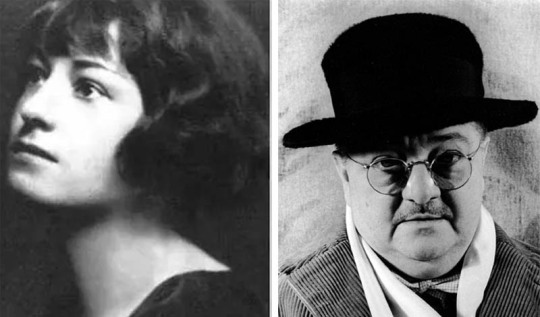
#New York#NYC#vintage New York#1920s#mysteries#detective novels#Dorothy Parker#Alexander Woollcott#George Raft#Polly Adler#Texas Guinan#George Baxt#vintage NY#Roaring 20s#Roaring Twenties#Jazz Age#crime fiction#Dorothy Parker Murder Case
33 notes
·
View notes
Text
A Timeline of "Tea for Two" in its Many Arrangements and Orchestrations
1925 - from the musical No, No, Nanette, by Vincent Youmans
youtube
1929 - also called Tahiti Trot, Op. 16, in Shosty's ballet The Golden Age. In 1929, Dmitri Shostakovich was challenged to re-orchestra "Tea for Two", from memory, by conductor Nikolai Malko.
youtube
(A preview of the Bolshoi Ballet dancing to the Tahiti Trot)
1933 - A recording by jazz pianist Art Tatum
youtube
1956 - A recording by jazz pianist Thelonious Monk
youtube
1959 - The Tommy Dorsey Orchestra ft. Warren Covington
youtube
#tea for two#tea#music#jazz#cha cha#groovy#classical composers#music theatre#musicals#No No Nanette#Vincent Youmans#Tahiti Trot#Shosty#Dmitri Shostakoich#orchestration#Bolshoi Ballet#theatre#ballet#jazz pianist#Art Tatum#Thelonious Monk#jazz standard#big band#Tommy Dorsey Orchestra
2 notes
·
View notes
Photo
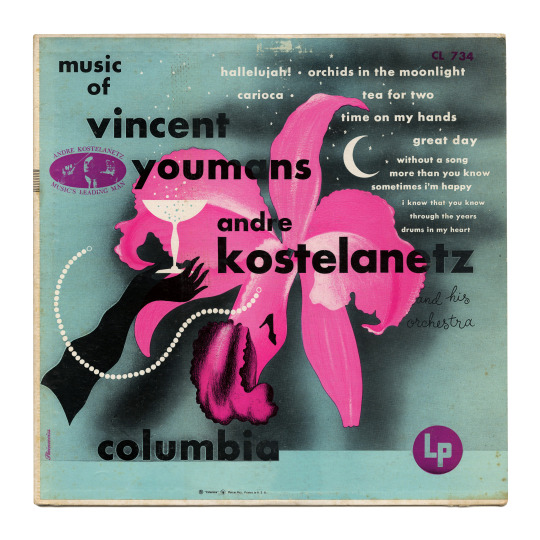
Music Of Vincent Youmans
André Kostelanetz And His Orchestra
Columbia Records/USA (1955)
49 notes
·
View notes
Text
11/24 おはようございます。Ralph Towner / Blue Sun ECM1250 等更新しました。
Billie Holiday / All or Nothing at All v6-8329
Bobby Hackett / In A Mellow Mood t-575
Pat Moran / Quartet Bcp6007
Zoot Sims / New Beat Bossa Nova Cp435
Bob Brookmeyer Al Cohn / Storyville Presents Bob Brookmeyer STLP305
Oscar Peterson / Plays The Harry Warren And Vincent Youmans Song Books mgv2059
Ben Webster / Soulville mgv8274
Johnny Hodges / at the Sportpalast Berlin 2620102
Chet Baker & Paul Bley / Diane scs1207
Chet Baker / Someday My Prince will Come scs1180
Ike Isaacs / the Tender Touch st447
Chet Baker / Live in Sweden Drlp56
Tony Williams / Believe It pc33836
Jon Lucien / Mind's Eye apl1-0493
Ralph Towner / Works 823268-1
Ralph Towner / City Of Eyes ECM1388
Ralph Towner / Solstice ecm1060st
Ralph Towner / Blue Sun ECM1250
Egberto Gismonti / Solo ecm1136
Egberto Gismonti / Danca Das Cabecas ecm1089
~bamboo music~
530-0028 大阪市北区万歳町3-41 シロノビル104号
06-6363-2700

0 notes
Text
Birthdays 9.27
Beer Birthdays
Samuel Adams (1722)
Eberhard Anheuser (1806)
Carl Adolf Riebeck (1821)
Conrad Seipp (1825)
Charles L. Centlivre (1827)
Louis Alphonse Centlivre (1857)
Frank D. Yuengling (1876)
David Farnsworth (1927)
Five Favorite Birthdays
Randy Bachman; rock guitarist, singer (1943)
Wilford Brimley; actor (1934)
Thomas Nast; cartoonist (1840)
Bud Powell; jazz pianist (1924)
Jim Thompson; writer (1906)
Famous Birthdays
Henri Frederic Amiel; Swiss writer (1821)
Harry Blackstone; magician (1885)
Shaun Cassidy; pop singer (1958)
William Conrad; actor (1920)
Don Cornelius; "Soul Train" television show host (1936)
George Cruikshank; illustrator (1792)
Cassandra Cruz; porn actor (1982)
Cytherea; porn actor (1981)
Cosimo de' Medici; merchant prince (1389)
Greg Ham; rock woodwind player, keyboardist (1953)
Dillon Harper; porn actor (1991)
Avril Lavigne; rock singer (1984)
Marc Maron; comedian (1963)
Meat Loaf; rock singer (1947)
Jayne Meadows; actor (1920)
Greg Morris; actor (1933)
Don Nix; baritone saxophonist (1941)
Gwyneth Paltrow; actress (1972)
Arthur Penn; film director (1922)
Mike Schmidt; Philadelphia Phillies 3B (1949)
Jim Shooter; comic book writer, artist (1951)
Top Cat; cartoon character (1961)
Lil Wayne; rapper (1982)
Vincent Youmans; songwriter (1898)
1 note
·
View note
Text
ON SAX/BASS/DRUMS TRIOS
NICOLE GLOVER with Tyrone Allen and Kayvon Gordon, SMALL’S JAZZ CLUB, 21 AUGUST 2022, 1st set Couch Tour
LEW TABACKIN with Boris Kozlov and Jason Tiemann, SMALL’S JAZZ CLUB, 6 AUGUST 2022, 2nd set Almost Couch Tour
RUDRESH MAHANTHAPPA with and Rudy Royston, SMOKE JAZZ CLUB, 26 AUGUST 2022, 2nd set Couch Tour
No chordal instrument is daring and, since my first exposure was Ornette Coleman, it has also meant VERY daring. Then there was John Coltrane having McCoy Tyner sit out for Chasin’ the Trane and Sonny Rollins at the Village Vanguard. But then Gerry Mulligan and Chet Baker had a significant quartet and Warne Marsh played with Red Mitchell. There’s also Lee Konitz’s Motion which, cool school and standards be damned, is one VERY daring album. More recently Mark Turner has recorded with the Fly Trio and Melissa Aldana had Crash Trio.
NICOLE GLOVER favors this format and she is a bold player, but Tyrone Allen and especially Kayvon Gordon and much subtler than her previous team of Daniel Duke and Nick Capaccio. And that allows her to be subtler too. There’s probably also more than some defensiveness in her no nonsense approach, but at this show she actually introduced tunes and bandmates. She acknowledged that this was a good audience (a Sunday 7/9:30 gig, not the usual Thursday at 10:30 one) which she commented that she only says when she means it. So she was in a good performer mood, not simply good musician mood. She is articulate, but probably both shy and disinclined to prevaricate. They opened with the likely original Open or Close which I wondered if it was Ornette Coleman with both spare figure/riff opening into a twisty melody. Allen had an acceleration and was, as the format demands, steady and full. It was Gordon who could dance around amusing himself and us with thoughtful comments. They are a good team and they serve her music too. She does Clifford Jordan’s Glass Bead Games often and it was welcome here in its early 1970s glory. Allen’s A Side was bass driven yes but much more than a riff. She arranged Vincent Youman’s Without A Song (and damn if I didn’t hear the bridge from The Song Is You in there). It was very much forward looking but I have not been aware of her doing Great American Song Book standards much. Instead it’s typically worthy fare like the Mulgrew Miller closer Eleventh Hour. As a WGCO podcast with Nate Chinen put it, she’s a bad ass with a capital B, but it’s good to see her take advantage of this band to find more spaces in the music.
LEW TABACKIN has been a name only for the entirety of my jazz listening, pigeon holed as the lead voice in the big band he co-led with Toshiko Akiyoshi. From what I read, she was the composer and arranger, but still it was a big band. But he’s been playing in this sparest of formats for a time, often with Boris Kozlov on bass. He’s 82 now and Akiyoshi, still alive, is 93 this year. He’s a bit of a gruff old man (I may be projecting) but he is full, inventive, and active. I kept thinking of Konitz but, frankly even more, Rollins. All three know tons of tunes and their improvisation is linear and melody based rather than chordal. The first was a standard I of course didn’t place but it stretched without filler. Garden at Light Time seems to be a regular flute showcase and it was evocative, as it was meant to be, of Japan. Plenty of “Orientalism” but also some realism and grit. Oscar Pettiford’s Tricotism had drive and intricacy for both Kozlov and Tabackin. Billy Strayhorn’s Chelsea Bridge was wonderful but a jazz piece to honor by stretching. Tabackin’s on Studio F, he described as free bop, but it also had a Monk quote and lots of busy playing. The closer was necessarily short but had a pleasant relaxed swing. He’s an interesting player and, not that he did, he doesn’t need to hide in Akiyoshi’s arrangements.
RUDRESH MAHANTHAPPA reconvened his Hero Trio to continue his rich engagement with Charlie Parker’s music. Rudy Royston is still magic behind the kit but Harish Raghvan replaces Francois Moutin on the bass. Raghvan’s playing was solid and just what is needed in this situation, of a piece with Allen with Glover and Kozlov with Tabackin, but I found his tone shallow. I’m perfectly willing to blame the room or the feed, but Smoke’s streams are usually so good. And, to be fair, Royston’s crisp cymbals and rolling tom toms were rich. Together they created quite a bed for Mahanthappa’s alto. The Parker tunes were deeper in the catalog as I hadn’t even heard the opener Segment. It took me a moment to get my bearings and, frankly, it didn’t seem all that Parkerish, rather like his Bird Calls album. Still the table was set to capture Parker’s playful spirit and humor and, particularly on Parker’s Red Cross, I could hear the play that Ornette Coleman also tapped into. They also did I Can’t Get Started and I’ll Remember April (also on Lee Konitz’s Motion in precisely this ensemble) to make the point that Parker played popular songs and not the Great American Song Book of jazz standards. To that end, he played Stevie Wonder’s Overjoyed in honor of all the music he heard on Sesame Street. But the most memorable tune was the theme to the video game Animal Crossing. It was catchy and jaunty and, though I can’t be sure where the theme bled into the improvisation, it was a reminder that jazz is everywhere. I came to a deeper appreciation of Mahanthappa’s appealing musical spirit and new levels of accessibility emerged for me.
This trio format requires an inventive, melodic horn (Glover is allowing herself more space with her new more lithe rhythm section; Tabackin was remarkably so; and I could hear more of Mahanthappa’s aesthetic this time around), strong basses as the rock (check again, but they are the ones stuck with the heavy lifting), and dancing drummers (Gordon got to subtly flavor things with Glover whereas Royston was more of a force but sill light on his feet.).
The sax/bass/drums combination is a challenge these nine musicians met in worthwhile ways. It was good to explore it with them.
#concert review#jazz#couch tour#almost couch tour#smoke jazz club#small’s live#small’s jazz club#2022
0 notes